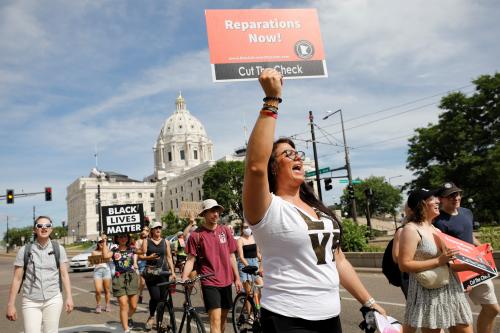- Mar 11, 2015
- 84,189
- 51,247
- 2,645
It seems that the concept of reparations is a problem. Apparently that is based on a lack of knowledge about history. Most just reflexively while not really knowing the iinformation that makes the case for reparations. So it appears that an education as to why reparations should be paid needs to happen and included is the information that can and will be used as part of the case.
The opposition to reparations being paid for something that happened 200 years ago is invalid, you will see why in a few seconds.
The United States has used reparations—targeted initiatives intended to concretely repair a harm against a person or persons resulting from the collective action of others—as a means of acknowledging and atoning for its role in other atrocities, including the internment of Japanese Americans and the forced removal and destruction of six indigenous communities: the Ottawas of Michigan, the Chippewas of Wisconsin, the Seminoles of Florida, the Sioux of South Dakota, the Klamaths of Oregon, and the Alaska Natives.* However, the descendants of Africans enslaved on U.S. soil have been notably absent from this history of reparative actions. While the task of reparations seems daunting to many Americans considering the scale of injustice presented by slavery and its aftermath, we believe this is a conversation the country needs to have.
Given that white Americans gained the most from slavery and its compounded effects — a process referred to as unjust enrichment – is their widespread opposition to reparations rooted in maintaining this advantage?

 www.brookings.edu
www.brookings.edu
1970: Richard Nixon signed into law House Resolution 471 restoring Blue Lake and surrounding area to the Taos Pueblo (New Mexico). The land had been taken by presidential order in 1906. (A History of the Indians in the United States by Angie Debo (Norman, OK: University of Oklahoma Press, 1984, p. 422); see also "Taos Pueblo celebrates 40th anniversary of Blue Lake's return" by Matthew van Buren, Santa Fe New Mexican, September 18, 2010.)
The payments from 1971-1988 are taken from the booklet Black Reparations Now! 40 Acres, $50 Dollars, and a Mule, + Interest by Dorothy Benton-Lewis; and borrowed from N’COBRA (National Coalition of Blacks for Reparations in America).
1971: Around $1 billion + 44 million acres of land: Alaska Native Claims Settlement Act.
1974: A $10 million out-of-court settlement was reached between the U.S. government and Tuskegee victims, black men who had been unwitting subjects of a study of untreated syphilis, and who did not receive available treatments. (“The Tuskegee Timeline”, CDC, updated March 2, 2020.)
1980: $81 million: Klamaths of Oregon. ("Spending Spree" by Dylan Darling, Herald and News (Klamath Falls, OR), June 21, 2005.)
1980: $105 million: Sioux of South Dakota for seizure of their land. (United States v. Sioux Nation of Indians, 448 U.S. 371 (1980).)
1985: $12.3 million: Seminoles of Florida. (see Racial Justice in America: A Reference Handbook by David B. Mustard, 2002, ABC-CLIO, p. 81.)
1985: $31 million: Chippewas of Wisconsin. (see Racial Justice in America: A Reference Handbook by David B. Mustard, 2002, ABC-CLIO, p. 81.)
1986: $32 million per 1836 Treaty: Ottawas of Michigan. (see Racial Justice in America: A Reference Handbook by David B. Mustard, 2002, ABC-CLIO, p. 81.)
2016: The U.S. government reached a settlement of $492 million with 17 Native American tribes to resolve lawsuits alleging the federal government mismanaged tribal land, resources, and money. (“U.S. Government To Pay $492 Million To 17 American Indian Tribes” by Rebecca Hersher, NPR, September 27, 2016.)
2018: The Supreme Court, in a 4-4 deadlock, let stand a lower court's order to the state of Washington to make billions of dollars worth of repairs to roads, where the state had built culverts below road channels and structures in a way that prevented salmon from swimming through and reaching their spawning grounds, that had damaged the state’s salmon habitats and contributed to population loss. The case involved the Stevens Treaties, a series of agreements in 1854-55, in which tribes in Washington State gave up millions of acres of land in exchange for "the right to take fish." Implicit in the treaties, courts would later rule, was a guarantee that there would be enough fish for the tribes to harvest. Destroying the habitat reduces the population and thus violates these treaties. This decision directly affects the Swinomish Tribe. ("A Victory For A Tribe That’s Lost Its Salmon" by John Eligon, The New York Times, June 12, 2018.)
Were any of you alive when those tribes were forcibly removed or cheated?
The opposition to reparations being paid for something that happened 200 years ago is invalid, you will see why in a few seconds.
How we repair it: White Americans’ attitudes toward reparations
The United States is again at a crossroads of racial reckoning. The death of George Floyd and the 2020 summer of protests for racial justice added new urgency to ongoing discussions about the legacy of slavery and its contemporary implications for the lives of Black Americans. A key question at the root of this discussion is: how do we repair the harm – economic, physical, and psychological — caused to Black lives by slavery, Jim Crow, redlining, police brutality, and other manifestations of systemic racism?The United States has used reparations—targeted initiatives intended to concretely repair a harm against a person or persons resulting from the collective action of others—as a means of acknowledging and atoning for its role in other atrocities, including the internment of Japanese Americans and the forced removal and destruction of six indigenous communities: the Ottawas of Michigan, the Chippewas of Wisconsin, the Seminoles of Florida, the Sioux of South Dakota, the Klamaths of Oregon, and the Alaska Natives.* However, the descendants of Africans enslaved on U.S. soil have been notably absent from this history of reparative actions. While the task of reparations seems daunting to many Americans considering the scale of injustice presented by slavery and its aftermath, we believe this is a conversation the country needs to have.
Given that white Americans gained the most from slavery and its compounded effects — a process referred to as unjust enrichment – is their widespread opposition to reparations rooted in maintaining this advantage?

How we repair it: White Americans’ attitudes toward reparations | Brookings
Ashley V. Reichelmann and Matthew O. Hunt explore white Americans’ attitudes toward reparative policies and social factors affecting their views.
1970: Richard Nixon signed into law House Resolution 471 restoring Blue Lake and surrounding area to the Taos Pueblo (New Mexico). The land had been taken by presidential order in 1906. (A History of the Indians in the United States by Angie Debo (Norman, OK: University of Oklahoma Press, 1984, p. 422); see also "Taos Pueblo celebrates 40th anniversary of Blue Lake's return" by Matthew van Buren, Santa Fe New Mexican, September 18, 2010.)
The payments from 1971-1988 are taken from the booklet Black Reparations Now! 40 Acres, $50 Dollars, and a Mule, + Interest by Dorothy Benton-Lewis; and borrowed from N’COBRA (National Coalition of Blacks for Reparations in America).
1971: Around $1 billion + 44 million acres of land: Alaska Native Claims Settlement Act.
1974: A $10 million out-of-court settlement was reached between the U.S. government and Tuskegee victims, black men who had been unwitting subjects of a study of untreated syphilis, and who did not receive available treatments. (“The Tuskegee Timeline”, CDC, updated March 2, 2020.)
1980: $81 million: Klamaths of Oregon. ("Spending Spree" by Dylan Darling, Herald and News (Klamath Falls, OR), June 21, 2005.)
1980: $105 million: Sioux of South Dakota for seizure of their land. (United States v. Sioux Nation of Indians, 448 U.S. 371 (1980).)
1985: $12.3 million: Seminoles of Florida. (see Racial Justice in America: A Reference Handbook by David B. Mustard, 2002, ABC-CLIO, p. 81.)
1985: $31 million: Chippewas of Wisconsin. (see Racial Justice in America: A Reference Handbook by David B. Mustard, 2002, ABC-CLIO, p. 81.)
1986: $32 million per 1836 Treaty: Ottawas of Michigan. (see Racial Justice in America: A Reference Handbook by David B. Mustard, 2002, ABC-CLIO, p. 81.)
2016: The U.S. government reached a settlement of $492 million with 17 Native American tribes to resolve lawsuits alleging the federal government mismanaged tribal land, resources, and money. (“U.S. Government To Pay $492 Million To 17 American Indian Tribes” by Rebecca Hersher, NPR, September 27, 2016.)
2018: The Supreme Court, in a 4-4 deadlock, let stand a lower court's order to the state of Washington to make billions of dollars worth of repairs to roads, where the state had built culverts below road channels and structures in a way that prevented salmon from swimming through and reaching their spawning grounds, that had damaged the state’s salmon habitats and contributed to population loss. The case involved the Stevens Treaties, a series of agreements in 1854-55, in which tribes in Washington State gave up millions of acres of land in exchange for "the right to take fish." Implicit in the treaties, courts would later rule, was a guarantee that there would be enough fish for the tribes to harvest. Destroying the habitat reduces the population and thus violates these treaties. This decision directly affects the Swinomish Tribe. ("A Victory For A Tribe That’s Lost Its Salmon" by John Eligon, The New York Times, June 12, 2018.)
Were any of you alive when those tribes were forcibly removed or cheated?




